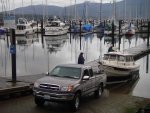pslansing@mac.com
New member
- Joined
- Sep 10, 2022
- Messages
- 9
- Reaction score
- 0
Greetings,
I'm pondering acquiring a C-Dory 22 or 23 for day fishing and the odd weekend overnight. I'm used to lightweight aluminum boats that can be loaded with the trailer a little dry (about a quarter of the bunks showing). You just drive the bow between the bunks, raise the motor appropriately, then drive on up to within a foot or so of the winch. Easy peasy. Is this an approved loading method with C-Dorys? I've never owned a glass boat so please advise. (And don't spare my feelings.) Cheers, Phil
I'm pondering acquiring a C-Dory 22 or 23 for day fishing and the odd weekend overnight. I'm used to lightweight aluminum boats that can be loaded with the trailer a little dry (about a quarter of the bunks showing). You just drive the bow between the bunks, raise the motor appropriately, then drive on up to within a foot or so of the winch. Easy peasy. Is this an approved loading method with C-Dorys? I've never owned a glass boat so please advise. (And don't spare my feelings.) Cheers, Phil


